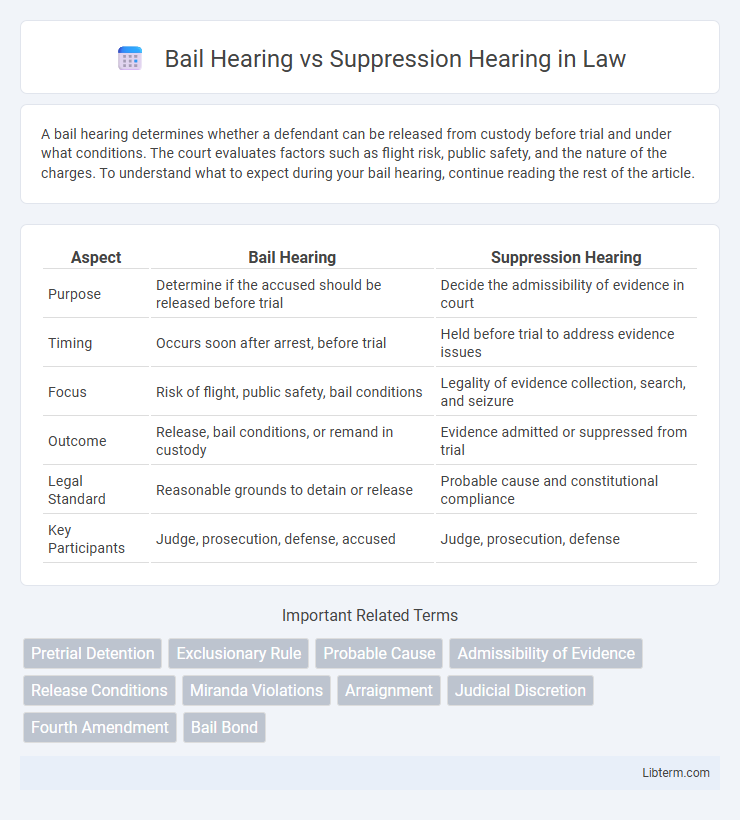A bail hearing determines whether a defendant can be released from custody before trial and under what conditions. The court evaluates factors such as flight risk, public safety, and the nature of the charges. To understand what to expect during your bail hearing, continue reading the rest of the article.
Table of Comparison
| Aspect | Bail Hearing | Suppression Hearing |
|---|---|---|
| Purpose | Determine if the accused should be released before trial | Decide the admissibility of evidence in court |
| Timing | Occurs soon after arrest, before trial | Held before trial to address evidence issues |
| Focus | Risk of flight, public safety, bail conditions | Legality of evidence collection, search, and seizure |
| Outcome | Release, bail conditions, or remand in custody | Evidence admitted or suppressed from trial |
| Legal Standard | Reasonable grounds to detain or release | Probable cause and constitutional compliance |
| Key Participants | Judge, prosecution, defense, accused | Judge, prosecution, defense |
Introduction to Bail Hearings and Suppression Hearings
Bail hearings determine whether a defendant should be released from custody before trial, focusing on factors like flight risk and community safety. Suppression hearings evaluate the admissibility of evidence, specifically assessing if evidence was obtained through violations of constitutional rights. Both hearings play critical roles in the pretrial phase, shaping the legal strategy and influencing case outcomes.
Definition of Bail Hearing
A bail hearing is a court proceeding where a judge determines whether a defendant should be released from custody pending trial and under what conditions, including setting bail amounts. This hearing assesses factors such as flight risk, public safety, and the defendant's criminal history to ensure appropriate pretrial release decisions. It differs from a suppression hearing, which focuses on the admissibility of evidence rather than the defendant's release status.
Definition of Suppression Hearing
A suppression hearing is a pretrial legal proceeding where the defense challenges the admissibility of evidence obtained, often alleging violations of constitutional rights such as illegal search and seizure under the Fourth Amendment. This hearing determines whether unlawfully obtained evidence should be excluded from trial to protect a defendant's rights. Bail hearings, in contrast, focus on setting conditions for a defendant's release pending trial rather than the admissibility of evidence.
Legal Purpose of Bail Hearings
Bail hearings serve the legal purpose of determining whether a defendant should be released from custody while awaiting trial, assessing factors such as flight risk, public safety, and the severity of the alleged offense. These hearings aim to balance the presumption of innocence with the need to ensure court appearance and community protection. Unlike suppression hearings, which focus on the admissibility of evidence, bail hearings concentrate on pretrial release conditions and risk assessment.
Legal Purpose of Suppression Hearings
Suppression hearings serve the legal purpose of determining whether evidence obtained in violation of a defendant's constitutional rights, such as through unlawful search or seizure, should be excluded from trial. This process ensures the protection of Fourth Amendment rights by preventing illegally obtained evidence from being used against the accused. Unlike bail hearings, which focus on setting release conditions, suppression hearings address the admissibility of evidence to uphold legal fairness and due process.
Key Differences Between Bail and Suppression Hearings
Bail hearings determine whether a defendant should be released from custody before trial and under what conditions, focusing on flight risk and public safety. Suppression hearings assess the admissibility of evidence, particularly whether it was obtained in violation of constitutional rights, such as through unlawful searches or coerced confessions. Key differences include bail hearings addressing pretrial release terms, while suppression hearings address evidence legality, impacting the prosecution's ability to use specific evidence at trial.
Procedures for Bail Hearings
Bail hearings involve the court determining whether a defendant should be released from custody pending trial, considering factors such as flight risk and public safety. During a bail hearing, the judge reviews evidence, hears arguments from the prosecution and defense, and sets conditions for release or denies bail. Procedures typically include presenting criminal history, risk assessments, and potential threats to community safety to guide the judge's decision on bail amount and restrictions.
Procedures for Suppression Hearings
Suppression hearings involve a detailed review of evidence to determine whether illegally obtained items can be excluded from trial, relying heavily on Fourth Amendment protections against unlawful search and seizure. The court examines motions filed by the defense, listens to testimonies, and evaluates the legality of police conduct before ruling on evidence admissibility. Unlike bail hearings, which focus on pretrial release conditions, suppression hearings address constitutional violations that impact the fairness of the trial itself.
Outcomes and Implications of Each Hearing
A bail hearing determines whether a defendant will be released from custody before trial, impacting their freedom and ability to prepare a defense; release conditions and bail amounts are critical outcomes influencing public safety and flight risk. A suppression hearing focuses on whether evidence obtained unlawfully should be excluded from trial, directly affecting the prosecution's case strength and the likelihood of conviction. Both hearings have significant implications on case strategy, defendant rights, and the judicial process.
Choosing the Right Legal Strategy
Choosing the right legal strategy involves understanding the distinct purposes of a bail hearing and a suppression hearing. A bail hearing determines whether the defendant can be released before trial, emphasizing factors such as flight risk and public safety. In contrast, a suppression hearing focuses on excluding illegally obtained evidence to strengthen the defense, making the timing and legal arguments critical for case outcomes.
Bail Hearing Infographic

 libterm.com
libterm.com